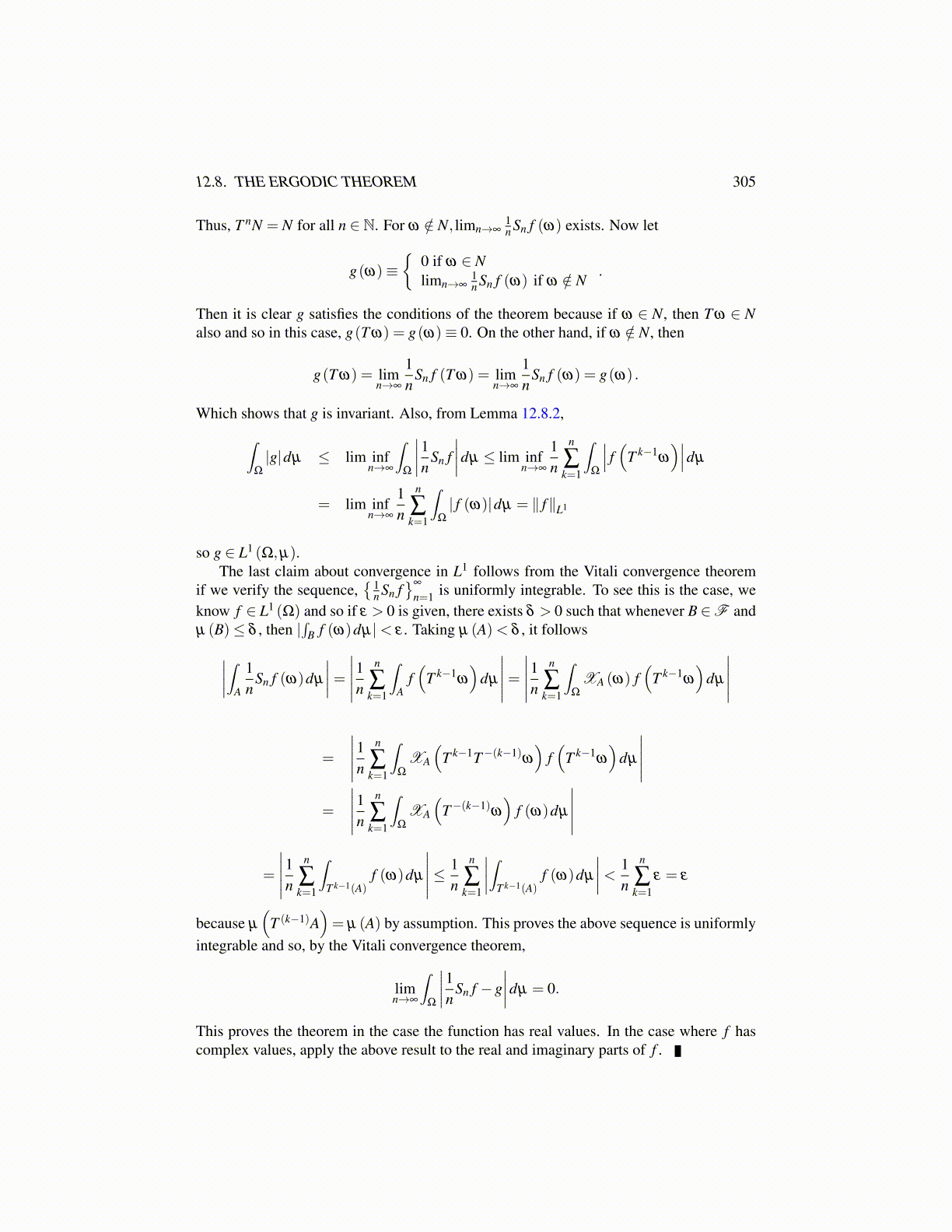
12.8. THE ERGODIC THEOREM 305
Thus, T nN = N for all n ∈ N. For ω /∈ N, limn→∞1n Sn f (ω) exists. Now let
g(ω)≡{
0 if ω ∈ Nlimn→∞
1n Sn f (ω) if ω /∈ N
.
Then it is clear g satisfies the conditions of the theorem because if ω ∈ N, then T ω ∈ Nalso and so in this case, g(T ω) = g(ω)≡ 0. On the other hand, if ω /∈ N, then
g(T ω) = limn→∞
1n
Sn f (T ω) = limn→∞
1n
Sn f (ω) = g(ω) .
Which shows that g is invariant. Also, from Lemma 12.8.2,∫Ω
|g|dµ ≤ lim infn→∞
∫Ω
∣∣∣∣1nSn f∣∣∣∣dµ ≤ lim inf
n→∞
1n
n
∑k=1
∫Ω
∣∣∣ f (T k−1ω
)∣∣∣dµ
= lim infn→∞
1n
n
∑k=1
∫Ω
| f (ω)|dµ = ∥ f∥L1
so g ∈ L1 (Ω,µ).The last claim about convergence in L1 follows from the Vitali convergence theorem
if we verify the sequence,{ 1
n Sn f}∞
n=1 is uniformly integrable. To see this is the case, weknow f ∈ L1 (Ω) and so if ε > 0 is given, there exists δ > 0 such that whenever B ∈F andµ (B)≤ δ , then |
∫B f (ω)dµ|< ε . Taking µ (A)< δ , it follows∣∣∣∣∫A
1n
Sn f (ω)dµ
∣∣∣∣=∣∣∣∣∣1n n
∑k=1
∫A
f(
T k−1ω
)dµ
∣∣∣∣∣=∣∣∣∣∣1n n
∑k=1
∫Ω
XA (ω) f(
T k−1ω
)dµ
∣∣∣∣∣=
∣∣∣∣∣1n n
∑k=1
∫Ω
XA
(T k−1T−(k−1)
ω
)f(
T k−1ω
)dµ
∣∣∣∣∣=
∣∣∣∣∣1n n
∑k=1
∫Ω
XA
(T−(k−1)
ω
)f (ω)dµ
∣∣∣∣∣=
∣∣∣∣∣1n n
∑k=1
∫T k−1(A)
f (ω)dµ
∣∣∣∣∣≤ 1n
n
∑k=1
∣∣∣∣∫T k−1(A)f (ω)dµ
∣∣∣∣< 1n
n
∑k=1
ε = ε
because µ
(T (k−1)A
)= µ (A) by assumption. This proves the above sequence is uniformly
integrable and so, by the Vitali convergence theorem,
limn→∞
∫Ω
∣∣∣∣1nSn f −g∣∣∣∣dµ = 0.
This proves the theorem in the case the function has real values. In the case where f hascomplex values, apply the above result to the real and imaginary parts of f .